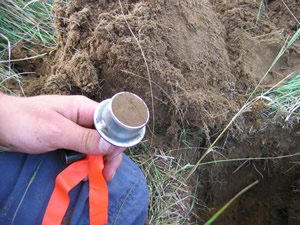|
Carbon Science
|
||||||||||||||||||||||||||||||||||||||||||||||||||||||
 |
Photo: 19 Year old White Ash plantation, Ontario |
As steward to one-tenth of the world's forests, Canada has a vested interest in the sustainability of its forests. Besides studying how climate change might cause an increase in forest disturbances, the Canadian Forest Service is also researching the carbon exchanges between Canada’s forests and the atmosphere.
Read more about the:
Carbon Accounting Tools
The Canadian Forest Service has been tracking carbon stocks and fluxes
in forest ecosystems since the 1980s through the Carbon Budget Model of
the Canadian Forest Sector, a computer simulation which incorporates observed
inventory data and numerically modeled processes. Carbon accounting information
is vital not only to address the reporting requirements of the Kyoto Protocol
now that it is ratified, but for reporting land use changes and carbon
credit trading domestically or internationally, should Canada pursue that
option.
The Pacific Forestry Centre (PFC) is focussed on developing a carbon accounting framework for the country. Since carbon dioxide is a major greenhouse gas, estimating the size of carbon exchanges between the atmosphere and the forest is central to climate change research. Whether forest carbon stocks are increasing – a carbon sink, or decreasing – a carbon source, fluctuates over time.
The PFC’s Carbon Accounting Team (CAT) has developed tools to estimate the contribution of afforestation to Canada’s forest carbon budget. In order to track changes in carbon stock resulting from afforestation, an inventory of afforestation projects is needed. The CAT has developed a database that can be updated via the internal CFS network. The CAT has also developed an internet based reporting system that could be accessible to outside users called the National Afforestation Inventory (NAI).
The Carbon Budget Model (CBM-CFS3) is a landscape level forest carbon accounting framework that simulates carbon dynamics under given parameters. The CBM-CFS3 model is being used to monitor past forest carbon stock changes and to predict future carbon stock changes through scenario and risk analysis. CAT is upgrading CBM-CFS3 to enable users to estimate the carbon budget of existing or planned afforestation projects.
To read more about the cutting edge carbon accounting research, please visit our Forest Carbon Accounting website.
National Afforestation Inventory (NAI)
Reporting of future afforestation projects to a carbon tracking system
could help verify carbon offsets and facilitate national reporting. The
CAT’s internet based reporting tool was developed to facilitate
reporting of future afforestation projects (e.g., Forest 2020 PDA and
other afforestation actions that may arise from the development of an
offset trading system). This system links an inventory of afforestation
projects with spatial information and CBM-CFS3 to track carbon sequestration
impacts. Users can input and access information with any internet browser.
CAT also drew on their experience developing the national database for
compiling information on historical afforestation.
To read more about the NAI or to register any afforestation projects you may be undertaking, please visit our NAI web-site:
To learn about the Forest 2020 PDA demonstration sites that have been logged into the NAI, please follow the link below:
Measurement and Monitoring Protocol
 |
Photo: Soil carbon sampling |
International rules governing this type of carbon measurement have not yet been firmly established, but the Northern Forestry Centre (NoFC) has taken an initial step in developing measurement and monitoring protocols that will contribute to our eventual reporting requirements.
The CFS has published a set of national guidelines to assist land managers interested in estimating carbon sequestration from afforestation/reforestation activities. The protocol will be tested for validating estimates of carbon sequestration through the Forest 2020 PDA initiative. The CFS Measurement and Monitoring Protocol was designed to comply with the strictest Kyoto reporting requirements. Information gained while developing it is expected to be used in Canada's Kyoto reporting process.
Based primarily on the NoFC’s experiences validating the prairie afforestation carbon sequestration estimates from 1990 through 2000, the guidelines also include information garnered from the Forest Carbon Management pilot series, measurement and monitoring research, federal Domestic Emissions Trading Offset policy development and any other relevant sources. The protocol includes: guidelines for a basic site assessment, and guidelines for detailed measurement and monitoring of growth and yield and additional site parameters important for carbon accounting.
Risk Assessment
There is always a risk that forest disturbances will jeopardise the carbon
sequestered in our forests. The CFS has taken steps to understand Canada’s
exposure to these risks and what needs to be done to mitigate these risks.
To read more about the risks inherent in afforestation, please follow the links provided:
Historical Backcast of Afforestation
Since the Kyoto Protocol has come into force, Canada is able to claim
credit for carbon sequestered during the commitment period by afforestation
projects dating back to 1990. To estimate the potential contribution of
past afforestation towards achieving Canada’s Kyoto target, CFS
regions have collected and recorded information on the extent of the privately
owned and Crown land that has been afforested/reforested from 1990 to
2002. This historical afforestation information is stored in a national
database and has been utilized to help derive carbon sequestration impacts
for 2008 to 2012.
To read more about Canada’s historical rates of afforestation and the CFS research on this topic, please read the report provided below:
Index | Demonstration
Sites | Economic Analysis
Carbon Science | Investment
Option Analysis
Afforestation and the Kyoto
Protocol
Land
Suitability | Report Summaries
| Contact Information
Français | Contact
Us | Help | Search
| Canada Site
CFS Site | Site
Map | What's New | Links
| NRCan Site